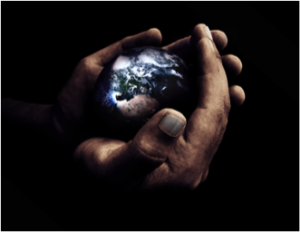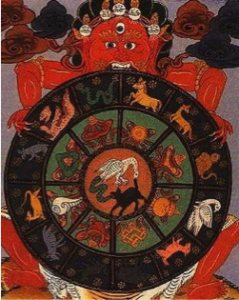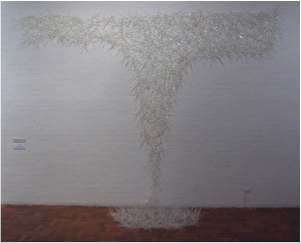 I know that a number of you, in growing awareness of the of the blind spots and shadow elements in the mental structure of consciousness, have been casting a fond glance toward indigenous cultures, which seem to offer counterbalancing strengths in precisely the areas where the mental structure is weakest: a deeper connection to the natural world, a more organic sense of belonging, and a greater awareness of the evocative power of ritual and the numinous. Your intuition is fundamentally correct, for part of the tragic hubris of the mental structure is its disdain for structures “less evolved” than its own and its conviction that it has “transcended and included” all previous developmental stages, bearing uniquely on its own shoulders “the axis and the arrow of evolution.”
I know that a number of you, in growing awareness of the of the blind spots and shadow elements in the mental structure of consciousness, have been casting a fond glance toward indigenous cultures, which seem to offer counterbalancing strengths in precisely the areas where the mental structure is weakest: a deeper connection to the natural world, a more organic sense of belonging, and a greater awareness of the evocative power of ritual and the numinous. Your intuition is fundamentally correct, for part of the tragic hubris of the mental structure is its disdain for structures “less evolved” than its own and its conviction that it has “transcended and included” all previous developmental stages, bearing uniquely on its own shoulders “the axis and the arrow of evolution.”
Still, one must proceed cautiously with this mythic turn. It has been tried twice already during the past century, and both times it has arrived at a dead end.
The first attempt got underway between the two world wars and gave birth to the movement known as Traditionalism. Under the guiding inspiration of the brilliant French metaphysician Rene Guenon (1886-1951), it immediately attracted some of the brighter minds of the early twentieth century and has continued to exert a significant (though mostly subterranean) influence on the intellectual current of our times. In addition to Guenon himself, some of the most prominent names associated with this movement include Ananda Coomaraswamy, Frithjof Schuon, Seyyed Hossein Nasr, Titus Burckhardt, Marco Pallis, and in a somewhat less “hardline” form Huston Smith. Thomas Merton was also attracted to many aspects of this teaching, and it is no secret that he was being actively courted by a Traditionalist circle at the time of his death. Many of you in our own Wisdom circle will have met some of these teachings through my former colleague Lynn Bauman, a student of Schuon and Nasr.
The Traditionalist tagline is perfectly encapsulated in the title of Mark Sedgwick’s groundbreaking study of this movement: “Against the Modern World.” To Guenon and his lineage, the perspectival turn (as Gebser calls it, not Guenon himself) represented a disastrous mistake: a tragic spiritual profligacy and perversion of the true path of Wisdom. That ancient path still remains, guarded in diasporas of traditional cultures and religious lineages, but regaining the right path requires a strict renunciation of Modernism and a return to the thought styles, artistic genres, spiritual practices and in some cases even dietary habits of those surviving traditional cultures which have not succumbed to the siren call of modernity.
 You will recognize a Traditionalist teaching when you hear one because it will inevitably begin with some variation of the theme, “We can all see that the modern world is going to hell in a handbasket,” then usually proceed to introducing the notion of the Kali Yuga, the famous “Dark Cycle” of Sanskrit provenance, which our own age is claimed to manifestly fulfill. There is a good deal of emphasis on authentic lineage transmission (as opposed to humanly-concocted religions) and an explicit orientation toward the past. The journey back to truth swims upstream against the river of time until one finally arrives at the headwaters “in the beginning…”
You will recognize a Traditionalist teaching when you hear one because it will inevitably begin with some variation of the theme, “We can all see that the modern world is going to hell in a handbasket,” then usually proceed to introducing the notion of the Kali Yuga, the famous “Dark Cycle” of Sanskrit provenance, which our own age is claimed to manifestly fulfill. There is a good deal of emphasis on authentic lineage transmission (as opposed to humanly-concocted religions) and an explicit orientation toward the past. The journey back to truth swims upstream against the river of time until one finally arrives at the headwaters “in the beginning…”
The conceptual flaw in this stance, from a Gebserian standpoint, is that it fundamentally mis-locates Origin. “In the beginning” is not on a linear timeline. The Origin is outside of linear time and “springs forth” (the literal meaning of the German word Ursprung) onto the world screen in the present, amid the cultural and consciousness structures currently prevailing. It cannot be found in the attempt to recreate earlier conditions as we project them in our own minds (another perspectival trap). At very best, such a misconstrued effort can only land us in the “deficient” stage of the structure we are trying to replicate: for the magic structure, in sorcery; for the mythic structure in psychic solipsism. The road we have traveled on our collective human journey toward consciousness cannot be undone—nor was there a wrong turn. Even the anguish of the deficient mental structure at the end of its vital lifespan has not been for naught, for in conferring on consciousness a whole new “world” of consciousness (the perspectival), it has laid the necessary structural groundwork for the emergence of the next unfolding.
The second “mythic revival” is of more recent vintage, roughly contemporaneous (and for good reason) with what we popularly call “the self-realization movement.” Its headwaters lie primarily in C.G. Jung and his game-changing discovery of the close correlation between the mythical as outer cultural form and as inner archetype. Gebser was onto this as well: he recognized the mythical structure as intrinsically tied to the emergence into human consciousness of the notion of the soul. But he also recognized—only too clearly—that when dealing with a structure as inherently fluid as the mythical, one has to keep a firm grip on the “yang.” He never permitted his construction of the mythical structure of consciousness to stray too far from its concrete historical and cultural underpinnings. Once that tether is cut, the mythic structure of consciousness can flow all too easily into a privatized and significantly gentrified interior landscape, where its primary purpose is to furnish the language, symbols, images, for our personal soul-work.
That was the coup de grace delivered by Joseph Campbell in his iconic The Hero with a Thousand Faces which catapulted him to fame, launched Parabola Magazine, and sparked a lively popular revival of interest in traditional cultures, crafts, artistic genres, and rituals—albeit mostly among the intellectual elite, and this time with aesthetic rather than Traditionalist dogmatic concerns predominating. The mythical structure of consciousness remerged as a fertile garden for cultivating “the rose within.” And thus it has largely remained to this day. In contemporary evolutionary models, such as Ken Wilber’s and Thomas Keating’s, it has lost virtually all connection to historical time and place and become merely the name for a developmental stage in individual human evolution.
Perspectival nostalgia in mythic drag.
 Just as Origin cannot be sought through a backward turn, Gebser insists, neither can it be sought through an inward turn. Yin and yang must be held in careful balance because it is on the playing field of our collective cultural journey—history in all messiness, violence, and shadow stuff—that every structure of consciousness has emerged into manifestation; and it is the very mass and weight of that full collective experience that creates the depth and staying power to call forth the new structure of consciousness. It cannot be born until it can be borne.
Just as Origin cannot be sought through a backward turn, Gebser insists, neither can it be sought through an inward turn. Yin and yang must be held in careful balance because it is on the playing field of our collective cultural journey—history in all messiness, violence, and shadow stuff—that every structure of consciousness has emerged into manifestation; and it is the very mass and weight of that full collective experience that creates the depth and staying power to call forth the new structure of consciousness. It cannot be born until it can be borne.
This time-tested cultural pattern is particularly true of the still-dawning Integral structure, which will add yet another dimension to the weight and heft of manifest reality and demand that we meet Origin there, in that new dimension we can as yet barely apprehend. In this dark and distinctly paschal season of Advent 2020, I swear I can sometimes sense it drawing near, as if on angels’ wings, to see whether the human heart has yet grown deep enough, stable enough, and courageous enough to endure the weight of both the individual and collective suffering that is the necessary price of conscious emergence.
A Note from Wisdom Waypoints:
We appreciate your comments, please share your reflections in the Comments section below.
Jeremy Johnson’s book: Seeing Through the World: Jean Gebser and Integral Consciousness, is available at Amazon.com or from the publisher, here at Revelore Press.
Image credits from the top: Earth in Hands, free image courtesy of pixy.org; The Kali Yuga, origin unknown; Emergence 1: The Transfiguration, sculpture image courtesy of artist Peter L Smith and English Wikipedia.

Our consciousness of consciousness awakens and expands.
Can’t go home again? I’m not so sure.
I’ve been a docent at the Anchorage Museum for the past 15 years. The History gallery used be laid out chronologically, and I would give a tour entitled “10,000 year of Alaska History”. I would start by saying that History, as we’ve learned it in school is crucial dates, 1066, 1492, 1776, primary documents like the Mayflower Compact and names of significant leaders. So in Alaska “History” doesn’t really begin until 1741 when the Europeans showed up and started writing things down. The gallery had dioramas that depicted pre-contact scenes of “Eskimos, Indians and Aleuts” that I would describe as “stone-age” cultures. Then the Russians showed up, a “more advanced” culture with metal tools, gunpowder and a written language. Russian Orthodoxy. Then the Americans came with steam engines, airplanes and the trans-Alaska pipeline. The rule of law. Progress, eh?
Well, about 8 years ago the museum began to “decolonize”. The History gallery was redesigned around themes and we put the replica of Vitus Bering’s ship in storage someplace. We docents (most of us white) have been educated in Native Alaskan culture, spirituality, and ways of knowing. It’s been eye- opening.
There has been, among Native people, a resurging interest in Native languages, dance and story telling. Native women are sporting traditional chin tattoos. We now have an Alaska Native Culture charter school here in Anchorage. And restored place names: Mt. McKinley to Denali, Barrow to Utkiaqvik.
And I think a part of this cultural movement is a restoration of an indigenous structure of consciousness, that never really disappeared, but has been maintained by village elders and passed down to all of us who are willing to listen. It sees that all creatures have a spiritual nature, that everything is connected and that traditional rituals and gestures are needed to keep everything on an even keel.